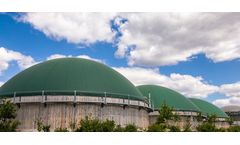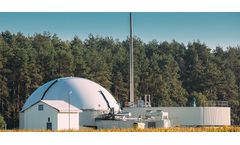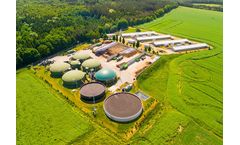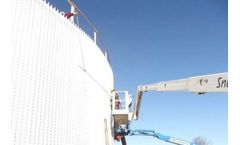Methane In Biogas Articles & Analysis
31 articles found
Introduction Biogas, a renewable energy source produced from organic waste, plays a critical role in reducing greenhouse gas emissions and providing sustainable energy. One of its primary components, methane, is essential for energy production, making its accurate measurement vital. This guide explores how to measure methane in ...
There is enormous potential to increase the extraction of energy from farm waste Agricultural waste is one of the largest sources of methane emitted into the atmosphere from human activities. Methane is a potent greenhouse gas but it’s also highly combustible, making it a valuable source of renewable energy when captured. Anaerobic digesters can convert ...
This process occurs naturally under the layers of buried waste in a landfill, producing methane and carbon dioxide, both greenhouse gases. The process can be mimicked in the controlled environment of a biodigester, and instead of emitting methane and carbon dioxide into the atmosphere, biogas is captured and used as energy. ...
Biogas, a methane-rich mix of gases created by anaerobic digestion, can be burned to generate electricity or heat, or it can be processed further to produce a valuable source of renewable energy. ...
Converting dairy waste into biogas and other valuable resources trims disposal costs, and saves water and energy Dairy and livestock farmers have been reaping the benefits of converting animal waste into biogas through anaerobic digestion. ...
Through anaerobic digestion, food and animal waste is recycled to produce hydrogen gas that can be subsequently converted to methane or biogas if needed.1,2,3 The Science Behind Anaerobic Digestion Anaerobic digestion is a complicated process which involves four major stages. ...
The most successful form of anaerobic digestion energy recovery is biogas production. Biogas is 50-75% methane, the main component of natural gas. ...
As the central link in the production of methane from waste, biogas tanks are where the waste is dumped and anaerobic digestion occurs. As the waste eventually produces methane, the gas can be safely transported for use as biofuel. What are the Problems Associated with Biogas Tanks? As the de-facto transformation of manure to ...
CH4 Biogas formed Synergy Biogas, LLC to build, own and operate a biogas facility at a Synergy Dairy that will produce renewable energy from manure and substrate. Synergy Dairy will provide a site for the facility and supply manure to the facility. The facility will digest manure from the ~2000 milking cows at the dairy along with manure from another Linwood managed dairy in the immediate area ...
Sensors for Hydrogen Production using Sewage Sludge During the studies, carbon dioxide and methane in the biogas were measured using the Edinburgh Sensors Gascard NG infra-red gas sensor. The Gascard was used to measure the infra-red energy absorbed by the gas sample at a characteristic wavelength which correlates with the concentration of carbon dioxide or ...
As part of the £60 million Thermal Hydrolysis Plant (THP) development, the BIODOME® gas holder units provide the site with 9000m³ of biogas storage. The biogas from the site has been utilised as various outputs; providing electrical power to 11,000 homes and gas to heat over 4,000 households. ...
“The methane-rich biogas produced by the ANUBIX™ process is reused to power an existing boiler unit, replacing baseline power requirements, which is a further benefit to the brewery,” said ...
Avoiding leaks is essential for accurate measurement of biogas production by batch assays. Here we present a simple method for detecting leaks and correcting results, based on the change in bottle mass during incubation. ...
Through anaerobic digestion, food and animal waste is recycled to produce hydrogen gas that can be subsequently converted to methane or biogas if needed.1,2,3 The Science Behind Anaerobic Digestion Anaerobic digestion is a complicated process which involves four major stages. ...
Methane is a biogas produced from swine or cow manure, as well as food processing and meat packing waste. ...
Abstract Anaerobic digestion is quickly becoming the choice technology for sewage sludge treatment at wastewater treatment plants, as the methane rich biogas produced is a valuable resource which can be used to generate electricity. In the oxygen restricted environment, a natural by-product of the anaerobic process is hydrogen sulfide, a harmful contaminant. ...
Two-stage AD technology separates the different sub-processes of the AD in two distinct reactors, enabling the use of optimal conditions for the different microbial consortia involved in the different process phases, and thus allowing for higher applicable organic loading rates (OLRs), shorter hydraulic retention times (HRTs) and better conversion rates of the organic matter, as well as higher ...
Methane production, process stability and energy balance were analyzed. Results showed that solid-state NaOH pretreatment significantly improved biogas and methane yields of 30-day anaerobic digestion, with increases from 143.7 mL/g volatile solids (VS) added to 157.1 mL/g VS –192.1 mL/g VS added and from 81.8 mL/g VS added to 88.8 mL/g VS–117.7 ...
Abstract An increasing effort is put into the utilization of organic waste streams in anaerobic digesters, producing useful products such as fertilizers and biogas. It becomes increasingly attractive to upgrade biogas to natural gas quality and consequently liquefy the gas to Bio-LNG. ...
The potential to recover bioenergy from anaerobic digestion of water hyacinth (WH) and from its co-digestion with fruit and vegetable waste (FVW) was investigated. Initially, biogas and methane production were studied using the biochemical methane potential (BMP) test at 2 g volatile solids (VS) L−1 of substrate concentration, both in the ...















